Manufacturers are especially inventive when it comes to carrying and storing the National Fire Protection Association (NFPA)-required complement of ground ladders on fire apparatus.
They’ve developed configurations for through the tank, alongside the tank, above the hosebed, alongside the hosebed, outside the hosebed, and others, each aimed at responding to the needs of the department purchasing the rig.
Nicole Riggles, pumper product manager for Pierce Manufacturing Inc., says that of all the locations where ground ladders are carried on pumpers, inside a compartment alongside the water tank continues to be the most popular among rigs Pierce has built. “This location, on a beam inside a covered compartment with the ladders drawn out to the rear, took off about three to four years ago and is still going strong,” Riggles points out. She adds that the two next most popular configurations for carrying ladders are stationary racks over low side compartments and hydraulic racks.
- Podcast: A Ground Ladder Assessment’s Impact on Apparatus Design
- Apparatus Purchasing: Ground Ladder Considerations
- Apparatus Purchasing: Specify Enough Ground Ladders
- Apparatus Purchasing: Truss Ground Ladders
- Iron Men and Wooden Ladders
- A Ground Ladder Assessment’s Impact on Apparatus Design
- Ground Ladder Storage: Oops, I Didn’t Think of That
Tim Besser, sales manager at KME, says that the compartment preferences a department chooses have an effect on the locations where they can carry ground ladders. “Along with compartmentation, low hosebed designs and weather protection are also for where the ladders can be located,” Besser points out. “With a low hosebed design, the ground ladders are usually carried on the outside of the apparatus, like on overhead hydraulic racks or drop-down side racks. We are seeing a lot more drop-down racks on engines because they don’t require as much space to deploy—only about 30 inches off the side of the vehicle instead of six feet for an overhead rack.”
Wyatt Compton, sales engineer for Spartan Emergency Response (ER), notes that Spartan ER offers various locations for carrying ladders, from open side storage to overhead racks to ladder boxes that deploy ladders off the rear of the rig. “We’ve also built ground ladder compartments through the center of a water tank,” he says, “and occasionally in their own separate box in a nonlow-hosebed configuration.”
Compton adds that side hydraulic racks are popular in places where geographical considerations like tight streets, alleys, or roadways cramp the deployment of ground ladders. “Those racks push out and down about 3 feet away from the side of the truck and are great applications where there’s not much side clearance, or where nose-to-tail engine placement means you can’t pull ladders out of a rear-deploying ladder tunnel,” he says.
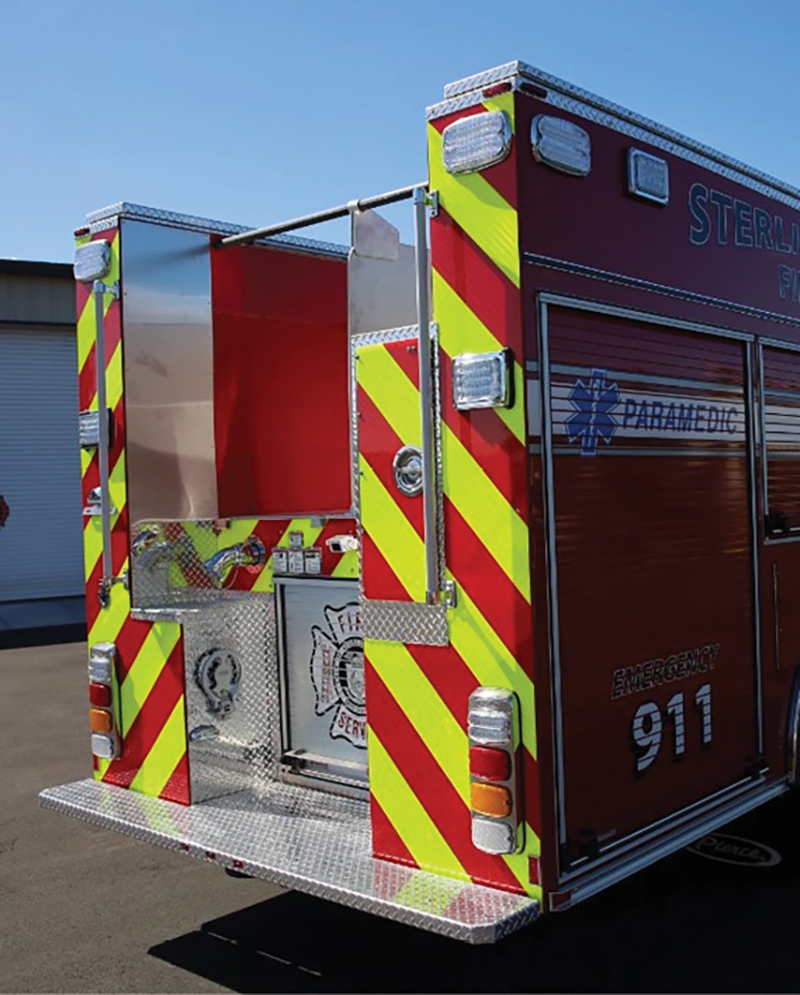
1 Inside a compartment alongside the water tank is the most popular method of ladder storage on pumpers that Pierce Manufacturing builds. (Photo 1 courtesy of Pierce Manufacturing Inc.)

2 KME built this pumper for the Bakersfield (CA) Fire Department with ladder storage on an overhead hydraulic rack. (Photo 2 courtesy of KME.)
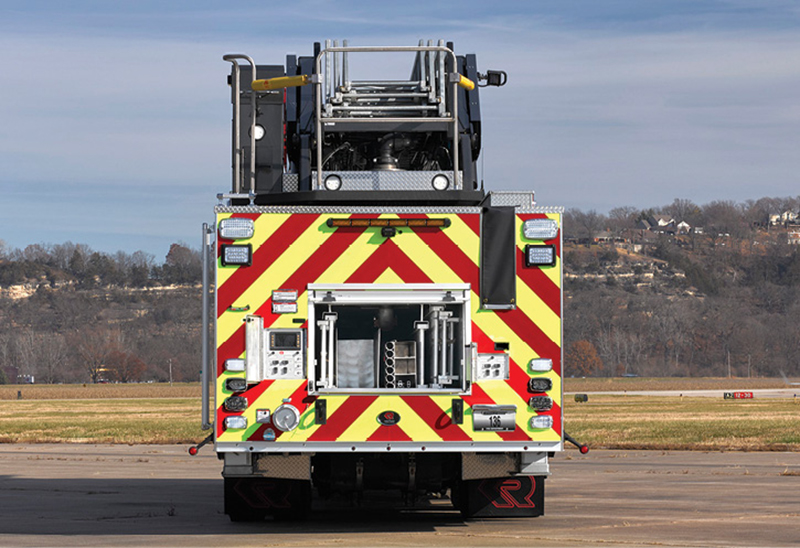
3 Rosenbauer built this 109-foot Viper aerial ladder with ground ladders through the torque box for the Cape Girardeau (MO) Fire Department. (Photo 3 courtesy of Rosenbauer.)
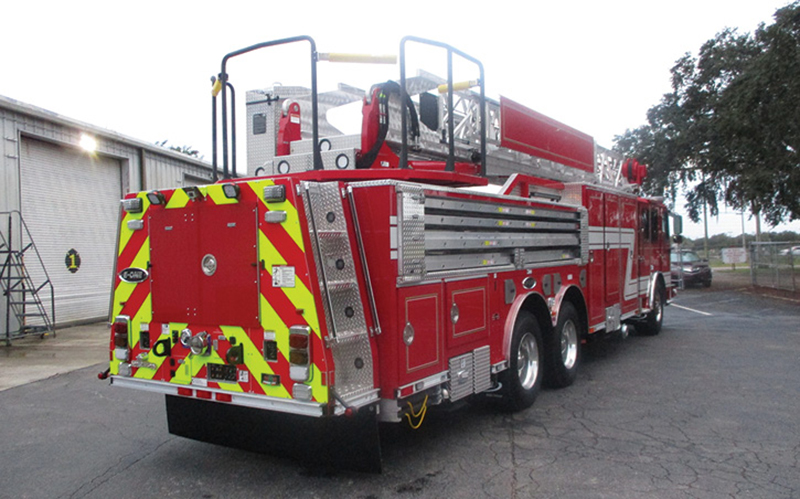
4 E-ONE offers added ground ladder storage on the side of aerials for easy access. (Photo 4 courtesy of E-ONE.)
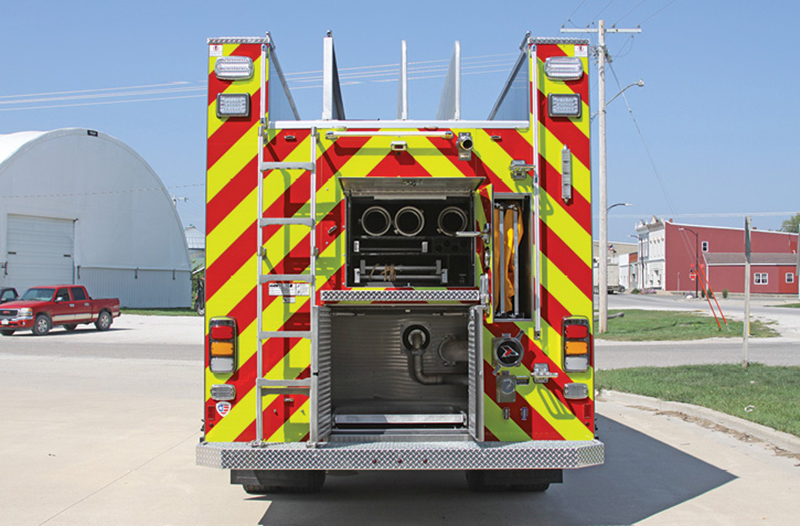
5 Toyne built this pumper with ladders laid flat surmounted by hard suction hose in a through-the-tank compartment. (Photo 5 courtesy of Toyne.)
Brett Monahan, aerial specialist for Rosenbauer, says his company offers several configurations for carrying ground ladders on aerials. “Most platforms and straight sticks have their ground ladders through the torque box,” Monahan observes. “But, when they want additional ladders, we put them on the side of the truck.” He cites a recently built 75-foot midmount aerial platform that has a three-section 35-foot extension ladder, a two-section 24-foot extension ladder, a 16-foot roof ladder, and a 10-foot attic ladder in racks on the side of the rig and 14-foot roof ladder on the fly section of the aerial.
Monahan says that Rosenbauer redesigned the torque box on a T-Rex aerial platform for the Whitehall Township (PA) Bureau of Fire to hold a three-section, 35-foot extension ladder and two 16-foot roof ladders, where the typical T-Rex torque box would carry a two-section 24-foot extension ladder and a 16-foot roof ladder. “Ground ladder location on pumpers and pumper-tankers depends on the fire department’s demographics,” he points out. “Those departments with tight streets are putting their ground ladders through the water tank,” he notes, “while a lot of rural departments are choosing ladder racks to allow more room in a hosebed or for a larger water tank. Everything is customizable now, reflecting what a fire department needs.”
Philip Gerace, director of sales for E-ONE, points out that E-ONE offers internal ladder storage for all its aerials. Gerace says, “For many models (100 feet and greater), we also offer additional ladder storage to the side of the aerial apparatus. For 75-foot and 78-foot aerial ladders, ground ladders are stored internally, outboard of the turntable support.”
Gerace notes that E-ONE offers additional ground ladder storage on the side of aerials for easy access where metal hinged doors with stainless steel twist latches secure the door to the body. He says, “Users just open the latches on both sides and slide the ladder horizontally on friction-reducing slides. Each door is tied to an ajar sensor to ensure the driver knows if a door was left open.”
Depending on the desired ladders, E-ONE’s most common body layout is a tall R1 compartment and low compartments through the remainder of the body. On a tandem-axle aerial with no pump or tank, E-ONE also provides side ladders with other tall compartments.
Typically in a rear center tunnel, E-ONE provides multiple ladders varying in size based on configurations but can accommodate even more with a wide tunnel design, Gerace points out. “The wide tunnel can add another two-section ladder and a roof ladder depending on length and other options,” he says. “Taking into consideration both a rear tunnel and side tunnels, we can hold 10 to 14 ladders—not including ladders on the outside of the ladder base section. Depending on the aerial device and configuration, E-ONE has designs that hold up to 50-foot three-section ladders.”
Zach Rudy, director of sales for Sutphen Corp., agrees that the most popular way to carry ground ladders on aerials is enclosed through the body of the vehicle. “But for those departments that want it, we can lower the compartments on one side to mount ladders on the exterior of the body,” Rudy says. “We’ve found that ladder placement depends on where the fire department is located. For instance, in the South, many departments run exposed ground ladders, while in the East and Midwest, where they get a lot of inclement weather, they keep the ladders enclosed.”
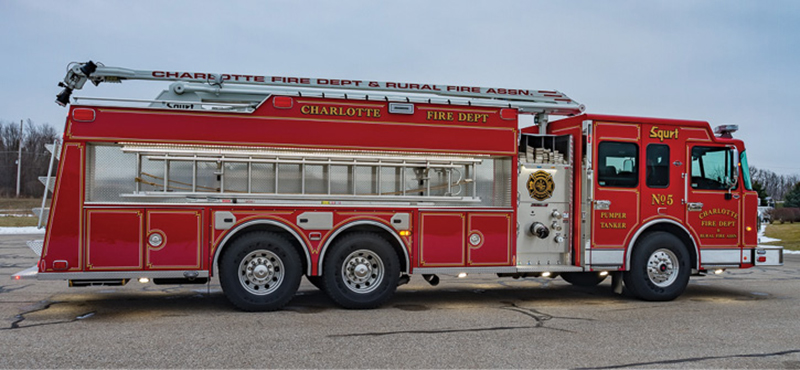
6 Spencer Manufacturing nested a two-section 28-foot extension ladder and a 16-foot roof ladder in an open compartment on this pumper for the Charlotte (MI) Fire Department. (Photo 6 courtesy of Spencer Manufacturing Inc.)
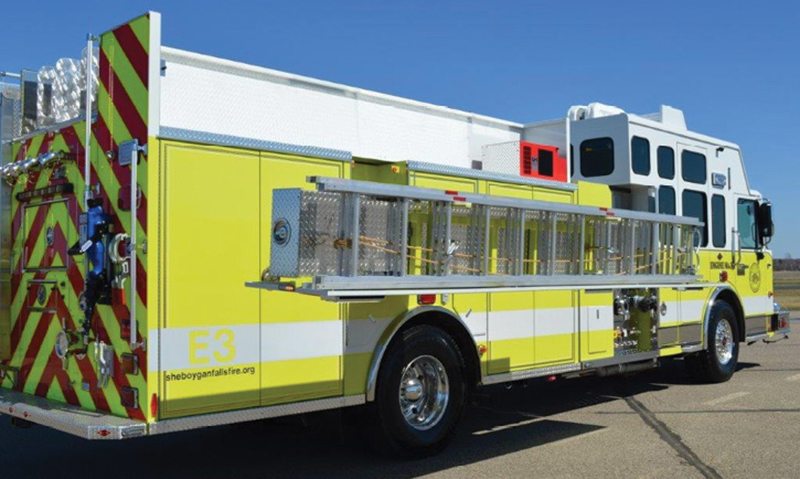
7 CustomFIRE built this pumper for the city of Sheboygan (WI) featuring a hydraulic drop-down arm for storing ladders and hard suction hose. (Photo 7 courtesy of CustomFIRE.)
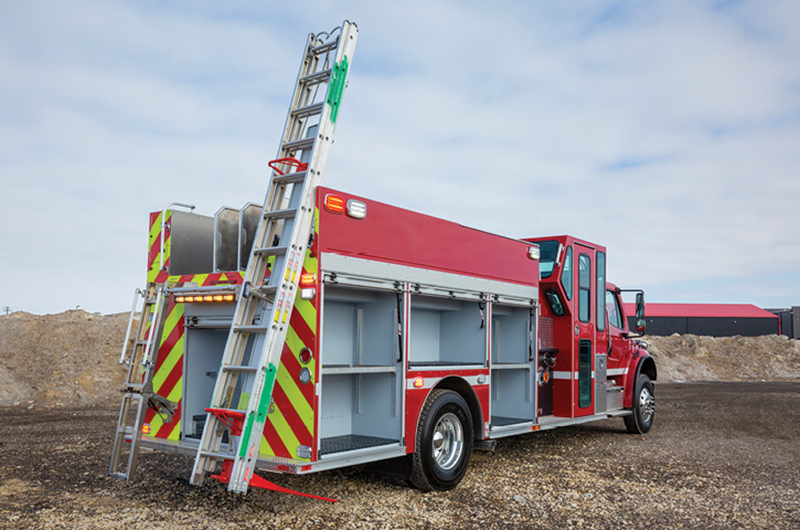
8 Fort Garry Fire Trucks built this pumper with a mechanically assisted ladder rack on top of the rig, which allows the rack to be lowered to the ground at the rear of the truck. (Photo 8 courtesy of Fort Garry Fire Trucks.)
Mike Watts, national sales manager for Toyne, notes that ladder storage comes in different forms based on apparatus layout. Apparatus bodies with the traditional low/low and high/low compartment configurations usually carry ladders externally above the low side compartments, either in a fixed rack or a unit like the Zico QUIC-LIFT electric or hydraulic rack to bring the ladders to a lower position for ease of access, Watts says.
“In the high/low configuration and the high/high split-depth compartmentation, there is an option for slide-in on-beam storage that is accessible from the rear of the truck, which is a popular option to keep ladders out of the weather but readily accessible from the ground,” Watts points out. “With full-depth, full-height bodies, ladders can be through the tank above the rear compartment, under the hosebed, or on a hydraulic rack. It boils down to the department’s decision on how they want the rig set up.”
Ben Bregg, design engineer for Spencer Manufacturing Inc., says Spencer designed a custom extreme duty ladder rack for the Pittsburgh (PA) Bureau of Fire that was made to be flush within the body of the engine. “It’s a side-mount rack made of ½-inch aluminum plate that’s contained in the overall length and height of the low-hosebed rig,” Bregg says. “There’s a pike pole and a 10-foot attic ladder nested inside a two-section 24-foot extension ladder and a 14-foot roof ladder.”
For the Charlotte (MI) Fire Department, Spencer nested a two-section 28-foot extension ladder and a 16-foot roof ladder in an open compartment in a pumper’s full-width body. “They wanted a traditional side mount of the ladders but also wanted the full width body, so this is how we accommodated them,” Bregg says. “We also mounted a 10-foot attic ladder below the ground ladders on the floor of the open compartment.”
Wayde Kirvida, sales engineer for CustomFIRE, says his company has seen a trend toward ground ladders in slide-in compartments. “We’ve not seen a lot of hydraulic ladder racks unless the body design calls for it, like with a greater number of compartments and bigger water tanks,” Kirvida says. “When you slide ladders in a through-the-tank compartment, you take between 200 and 225 gallons out of the tank, which a lot of departments don’t want to do. So, we see a lot of hydraulic racks, usually for volunteer departments, where they want water tanks of 750 to 1,000 gallons of water.”
Gordan Draskovic, director of engineering for Fort Garry Fire Trucks, says his company has placed ground ladders at all of the positions possible on engines. “Ladder racks above the hosebed or on the side of the body over compartments are still used a lot,” Draskovic observes, with Zico electric and hydraulic ladder racks seeing a lot of use. “Through the water tank ladder storage is becoming a most popular option,” he says, “and we’ve even put ladders in a manual rack above the hosebed that can be lifted up to free the hose and in a mechanically assisted roof rack that slides to the rear of the rig to allow the ladders to be removed from the ground.”
ALAN M. PETRILLO is a Tucson, Arizona-based journalist, the author of three novels and five nonfiction books, and a member of the Fire Apparatus & Emergency Equipment Editorial Advisory Board. He served 22 years with the Verdoy (NY) Fire Department, including in the position of chief.

